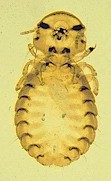Could be, though the head was the only place she had lice, not like the chickens that get them around the vent, legs, wings, and back.
-Kathy
So don't the regular larger lice drink? Actually, all the googling I have been doing does not show any difference in louse on poultry. I can find no mention of 'Ear Lice". Yet. I did find one article that listed four different types of louse, some were for waterfowl, another for hummingbirds, and hawks.
https://en.wikipedia.org/wiki/Bird_louse


